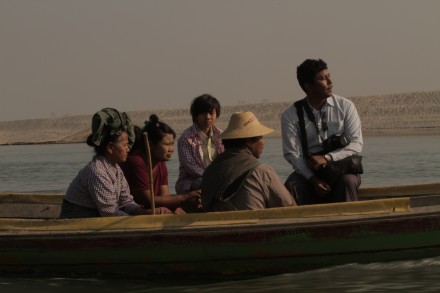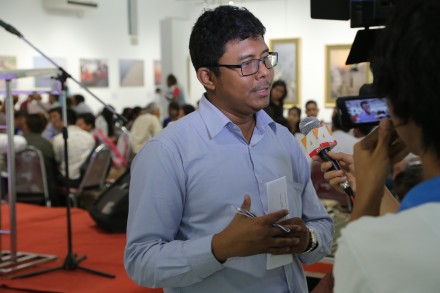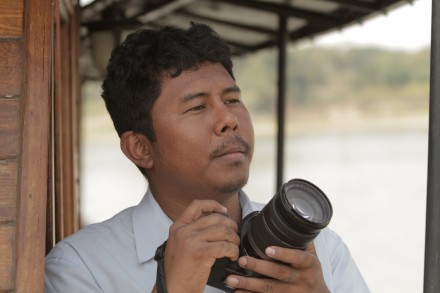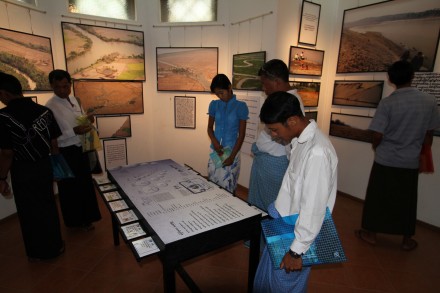Dodging censors and government control, Myint Zaw has helped save Myanmar’s Irrawaddy river from a Chinese dam through art. As JAMES GIGGACHER reports, he’s now been honoured with the world’s largest environmental prize.
The pen is mightier than the sword, they say, and in 40-year-old activist-journalist Myint Zaw’s case, the paintbrush and camera may be mightier than them all.
The Australian National University PhD student from Myanmar has just been honoured with the ‘Green Nobel’ and world’s largest award for environmental activism – the Goldman Environmental Prize.
In winning the award, Myint Zaw has joined five other crusaders from the world’s inhabitable continents celebrated in a special ceremony in San Francisco on 20 April.
Coming with US$175,000 to help further environmental work, the award recognises Myint Zaw’s efforts to stop a major government-backed Chinese hydroelectric dam project in Myanmar.
Facing heavy government scrutiny and restricted use of tools like email or social media, Myint Zaw launched a national movement that successfully stopped construction of the Myitsone Dam on Myanmar’s treasured Irrawaddy River.
Snaking its way from north to south for more than 2,000 kilometres, the Irrawaddy is not only the country’s longest river but most important commercial waterway. But as Western writers like Orwell and Kipling, as well as generations of Burmese have long known, the river is more than that – nearing the magical and the spiritual, it sweeps you up in its reverence.
It waters what the nation eats and enriches the soil in which food grows, brings sweet relief to parched lips, and cleanses the people, playing a vital role in the livelihoods and lives of Myanmar’s farmers and rural communities – some 70 per cent of the population.
Myint Zaw’s underground ‘Save the Irrawaddy’ campaign found ways around Myanmar’s then ruling military junta banning political meetings, censoring media and curbing Internet use to build massive public awareness of the potential human loss and environmental damage that the dam posed.
If the 6,000 megawatt project slated for the Irrawaddy’s watershed went ahead, it would potentially lead to the displacement of 18,000 people from 50 villages across their Kachin cultural heartland and the destruction of immense local biodiversity – while also putting millions of people downriver at risk.
It would also see 90 per cent the project’s vast electrical output surging back to China’s Yunnan province, leaving local communities in the dark when it came to acute energy needs. Yet again, here was a case of Myanmar’s leaders letting natural resources be extracted for the benefit of neighbours, big and powerful, rather than their own people.
Myint Zaw didn’t want that. He grew up swimming in the river and climbing the surrounding mountains. But he knew that the river was not just his – it was for everyone.
“I was born in a village near the Irrawaddy River delta,” Mr Myint Zaw says in a short film on the Goldman Environmental Prize’s website.
“I have always had a love for the river, which is the lifeblood of our people. Our culture depends on it.”
He must have taken comfort that his campaign soon had a powerful heartbeat; like the river, ‘Save the Irrawaddy’ soon belonged to everyone in Myanmar. In an interview with the LA Times, he recalls climbing into a taxi late one night only for the driver to recognise his voice from the shadows.
“You’re the man from the ‘Save the Irrawaddy,'” the driver said, referring to a video in which Myint Zaw and other activists argued that the proposed Chinese-led dam project would damage Myanmar’s most important river,” reads the report.
The cab driver went on to say that he had been so moved by the video that he made dozens of copies and handed out the DVDs to passengers. Thousands of other Burmese did the same.
“A country like us, we have a lot of ethnicities and a lot of issues dividing people, but when we talk about the Irrawaddy, it’s a unifying thing,” Myint Zaw tells the LA Times. “Maybe that made people listen more, and want to participate.”
It wasn’t just ordinary citizens who were quickly getting on board; the campaign quickly became a theme of opposition leader Aung San Suu Kyi’s speeches.
But perhaps most extraordinary, though not entirely surprising for a self-taught writer and photographer, is Myint Zaw’s use of the power of story-telling to make change. As an environmental journalist he began writing on rural issues but found his stories blocked by censors.
Nonetheless he knew the power and potential of the environment as a means to subtly talk about social issues. Undeterred by the taboo nature of politics, Myint Zaw began organising art exhibitions highlighting the ‘Save the Irrawaddy’ campaign. It was a smart move; galleries were among the only places in the country where activists, scholars, artists and citizens could meet to discuss sensitive issues while avoiding the keen eye of government.
“We were nervous during the first exhibit,” Myint Zaw says.
“So we only ran it for half a day. After our guests saw the show and heard the speeches, we quickly packed up and left.
“We were distributing scientific data and educational material without government permits. We were always worried about getting arrested.”
The series of art exhibits turned into a national advocacy movement. Artists began writing poems and songs about the river. Citizens spread pamphlets and DVDs about the dam in their own communities.
Soon the trickle became a surge. The campaign caught the attention of parliamentarians and local media, who took on the cause after being given more breathing space since the election of a new government and implementation of semi-civilian rule in 2011. The issue eventually reached the highest halls of power, and that same year President Thein Sein halted the dam’s construction, vowing that the project would not go ahead while he was in office.
The incredible turnaround speaks volumes for a rapidly-changing Myanmar, so long internationally isolated and tightly controlled – particularly when it came to the flow of information. It offers a hopeful glimpse of a country slowly but surely moving towards a more open and democratic system. With historic nationwide elections slated for later this year, it shows how far the country has come since the relaxation of military rule four years ago.
But the fight for the Irrawaddy is far from over. Chinese authorities and media are banging the drum for the resumption of the dam project. That’s a lot of noise to drown out. Meanwhile, Myanmar officials have said the decision on whether to resume the Myitsone dam project will rest with the administration that takes power after November’s elections.
Clearly more needs to be done; and with that Myint Zaw will not rest. He’ll continue to innovate and put ideas and ideals into action. In addition to completing his PhD in environmental management at Crawford School of Public Policy in the ANU College of Asia and the Pacific, Myint Zaw is set to keep campaigning for environmental and social causes.
As he’s told former alma mater, UC Berkeley where he studied journalism for a year, the money from the Goldman Environmental Prize will fund future activism on the Irrawaddy and beyond.
“We’re going to continue working on the Irrawaddy, of course, but there are a lot of other rivers in Myanmar, and Asia as a whole, that need help,” he says.
“We’re sticking with river conservation, but this prize will allow us to do a lot more work in a lot more places.”
For Myint Zaw, Myanmar and the broader region, the tide is turning, and a future of greater possibility is flowing.
James Giggacher is editor at The Australian National University’s College of Asia and the Pacific.
 Facebook
Facebook  Twitter
Twitter  Soundcloud
Soundcloud  Youtube
Youtube  Rss
Rss 



